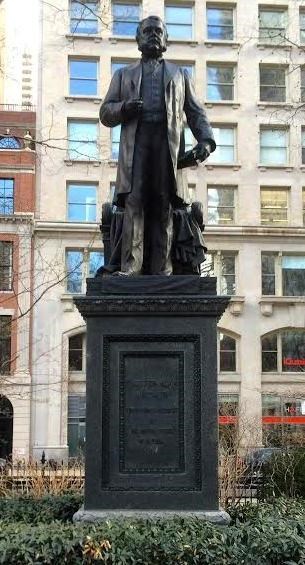
NPS
His firm was involved in two of the most important if forgotten cases of the antebellum period. When a Virginia couple stopped briefly in New York City in 1852 accompanied by their eight enslaved individuals, abolitionists sensed an opportunity to test the new Fugitive Slave Law. Though not yet a partner, Arthur helped win the case. Two years later Arthur defended an African American woman ejected from a Third Avenue streetcar. A century before Rosa Parks, Arthur argued this Civil Rights case in Brooklyn circuit court. New York's streetcars were desegregated. Eighteen sixty (1860) was a watershed year in American history. Abraham Lincoln became the first Republican to win the White House that November. South Carolina seceded on December 20, and that same week young Chet Arthur became General Chester Alan Arthur when Governor Edwin D. Morgan appointed him engineer-in-chief of New York State. Arthur was not entirely without military experience; like many young men in nineteenth century America, he had been a member of his state militia. One of Arthur's initial responsibilities in 1861 was upgrading and protecting New York's harbor defenses. This was no small task, as the harbor's numerous fortifications had been in a state of neglect since the young captain Robert E. Lee had upgraded them in the 1840s. Arthur did well, but he was a lawyer not an engineer. Morgan understood that his skills were best maximized elsewhere. The governor gave the young lawyer the additional responsibility of assistant quartermaster general of New York. Arthur was uniquely qualified for the task. He was also capable of working the long hours necessary. Provisioning the army was a mammoth task. Arthur directed the construction of a huge tent city located in City Hall Park in Lower Manhattan. Here, thousands of men were gathered, provisioned, and sent off to the war. Arthur was responsible for the disbursement of millions of dollars. There were some early mistakes, most notoriously in the purchase of 12,000 shoddy uniforms from Brooks Brothers Clothiers at the onset of the war. Still, such occurrences were rare under Arthur's watch. In February 1862 Arthur had a chance to visit the front when Morgan appointed him inspector general. Morgan recalled the indispensable Arthur to New York in late June and appointed him quartermaster general of New York State in early July. The rest of 1862 Arthur was busier than ever, working seven days a week in the Union cause. When New Yorkers elected Democrat Horatio Seymour governor in November 1862, Arthur lost his position to a member of the other party. General Chester Arthur's Civil War ended effective January 1, 1863. Waiting for him was his lucrative law practice; family, friends, and associates; and eventually the White House.
|
Last updated: May 30, 2021
